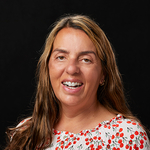Three graduate students earn awards to work at Lawrence Livermore
 (Download Image)
(Download Image)
Morgan Lindback, Ethan Welch and Xiao Kin Lu have earned Department of Energy Office of Science Graduate Student Research (SCGSR) Program awards to perform their doctoral dissertation research at Lawrence Livermore National Laboratory.
Three graduate students have earned Department of Energy Office of Science Graduate Student Research (SCGSR) Program awards to perform their doctoral dissertation research at Lawrence Livermore National Laboratory (LLNL). They are three among the 87 graduate students representing 33 states for the SCGSR program’s 2022 Solicitation 2 cycle.
Through world-class training and access to state-of-the-art facilities and resources at DOE national laboratories, SCGSR prepares graduate students to enter jobs of critical importance to the DOE mission and secures the national position at the forefront of discovery and innovation.
Morgan Lindback of the Ecology and Evolutionary Biology department at the University of Michigan, Ann Arbor; Xiao Kin Lu of the Chemical and Biological Engineering department at Northwestern University and Ethan Welch of the Physics department at the University of Nebraska-Lincoln are among the winners who will come to LLNL.
Morgan Lindback, University of Michigan, Ann Arbor
Lindback will work in the Environmental Microbiology group with host Xavier Mayali of the Environmental Isotope Systems Division.
“I'm grateful for the investment of time, energy, and funds that the DOE, LLNL, my host Xavier Mayali, and my current PI Melissa Duhaime have made in me and my science,” they said. “The opportunity to expand my scientific skills in this way wouldn't be possible without the support from DOE.”
Lindback studies microbes and their role in organic matter. Microbes are largely responsible for the transformation of organic matter (OM) across environments, making their complex, cross-domain trophic interactions essential components of global carbon cycling. It is well-documented that heterotrophic bacteria are major contributors to large reservoirs of recalcitrant dissolved organic matter (RDOM), but the microbial interactions, including viral infection, that give rise to these reservoirs are mostly unknown.
“My research at LLNL asks the question: How do viruses of heterotrophic bacteria alter the organic matter pool? With the help of my host scientist, Mayali, I'll be able to track the degradation of isotopically labeled OM across a multi-species microbial assemblage and determine which microbes benefit from OM degradation,” they said.
Lindback said they are specifically impressed with the incredible breadth of science SCGSR funds and LLNL being home to a similarly wide range of experts.
“I expect to meet many new people, learn about scientific endeavors outside of my field, gain new expertise and better understand the operation of the national labs,” they said.
Xiao Kin Lu, Northwestern University
Lu will work on fundamental electrochemistry for chemicals in materials science under LLNL’s Jiaqi Li of the Atmospheric, Earth & Energy Division.
"I am very excited,” Lu said. “It is a great honor that my personal values and research interests are recognized by the DOE. I went to college in the Bay, and my family is in the Central Valley. It is nice to be close to home again.”
Lu’s thesis research focus is about electrifying chemical and fuel production. He’ll be working specifically with Li on electrolytic dissolution of recycled cement or cement precursors.
“This program would allow me to collaborate with world-class researchers and have access to a wide range of characterization techniques,” Lu said. “Combining my background with Dr. Li's expertise in cement chemistry, I am thrilled to see what we can harness from electrocatalytic reactions.”
Ethan Welch, University of Nebraska-Lincoln
Welch will work in the Fusion Energy Sciences (FES)-Discovery Plasma Science program under LLNL’s Roni Shepherd of the Physics Division.
“It is an honor to be selected for the SCGSR fellowship,” Welch said. “I am excited to finally try my hand at a national lab and to work more with Ronnie Shepherd. I am very grateful to my advisers Matthias Fuchs and Bedros Afeyan for helping me throughout the application process.”
Welch said the goal of his fellowship is to develop a large time bandwidth product single shot plasma diagnostic. He started pursuing the field of high energy plasma physics shortly after earning his bachelor's degree from Brigham Young University.
“I was allured by the large and unexplored phase spaces made accessible by ever more powerful lasers,” he said. “Additionally, the field is on the cusp of many beneficial discoveries and applications that I want to be a part of. My hope is that, as part of this fellowship, I will contribute to those discoveries while developing the necessary skillset to be successful in this field.”
-------------------------------------
The SCGSR program provides a way for graduate students to enrich their scientific research by engaging with researchers at DOE national labs, learning from world-class scientists and using state-of-the-art equipment and facilities. In addition, they get valuable opportunities to network and observe firsthand what it’s like to have a scientific career.
SCGSR awardees work on research projects of significant importance to the Office of Science mission that address critical energy, environmental and nuclear challenges at national and international scales. Projects in this cohort span seven Office of Science research programs and three priority convergence research topical areas: Accelerator Science, Data Science and Microelectronics. Awards were made through the SCGSR program’s second of two annual solicitation cycles for FY 2022.
A list of the 87 awardees, their institutions, host DOE National Laboratory/facility, and priority research areas of projects can be found at the SCGSR website. For more information on SCGSR, please go to the SCGSR home page.
Contact
 Anne M. Stark
Anne M. Stark
[email protected]
(925) 422-9799
Related Links
Department of Energy Office of Science Graduate Student Research (SCGSR) ProgramTags
Earth and Atmospheric ScienceAtmospheric, Earth, and Energy
Nuclear, Chem, and Isotopic S&T
Nuclear and Chemical Sciences
Office of Science
Physics
Academic Engagement
Students
Physical and Life Sciences
Careers
Community Outreach
Featured Articles







